Category — Healthy Living
Quick ‘n’ Easy Ways to Upgrade Your Diet
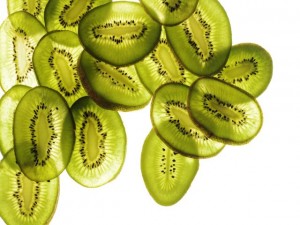
Since I started Semi-Sweet, people have asked me “do you really eat like that all the time?” “How on earth do you manage to avoid junk?” The answers are “no” and “I don’t!” I’m just like you, people. Have you not seen the Cheeto banner that comes up sometimes when you visit the site? I like junk food just as much as the next gal – it tastes good, right? Why wouldn’t it? It’s filled with salt and sugar and fat – all those ingredients make food tasty. But here’s my “secret,” I limit the quantity I eat. I practice little healthy habits that overall lead to a far healthier diet than the average American. If you’re looking for specifics, I’d say I eat crap once a week, usually on the weekend. I swear to you, if you start, slowly even, to incorporate more healthful, whole foods into your diet, you will notice a difference in the way your body feels. You will certainly be doing yourself a favor in the long run.
But for right now, say you’re not committed like I am to this whole foods lifestyle. Maybe you don’t like to cook so much. Yet you still want to amp up your nutrition and clean up your act in small ways? Here are some easy tips – try one a day if you can:
- Brew a pitcher of green tea and put it on ice for the week. You’ve heard the buzz about how good green tea can be for you – its catechins are purported to fight off some cancers and to speed up metabolism (although, I should be a skinny b*&tch for all the green tea I drink – so I’m not sure of this one).
- Buy some pre-shredded cabbage slaw mix and whip up a mayo-less slaw. Try my Asian Slaw, or one of the Cabbage recipes I posted earlier in the week. Research has linked a cabbage-rich diet (also other veggies in the brassica family like broccoli, brussels sprouts, cauliflower, collards and kale) to a lower risk of breast and other cancers.
- Try starting your meal with soup, or an apple. Researchers have shown that if you start out with a low-cal soup or an apple, you will feel fuller so you consume fewer calories. There are some nice veggie soups that are sold in aseptic packs – practice BPA-avoidance when you can. And I often eat an apple while I’m making dinner so I don’t “pre-eat” all the other stuff while I’m cooking.
- If you’re having trouble getting enough veggies into your diet, try drinking low-sodium vegetable juice. I don’t usually endorse juice as a fruit or vegetable replacement (and I don’t drink it myself) because you don’t get all the good fiber you would from eating whole food, but desperate times, people . . . . V-8 could be your ticket to 5-a-day.
- Serve fruits for dessert. They’re sweet, vitamin-rich and fiber-full. Once you start eating fewer Oreos and other processed sugary-stuff, you really will taste the sweetness in fruits. Trust me on this.
- Steer clear of candy with dried fruit. While dried fruit does have a lot of calories and sugar, it does at least have some food value and fiber.
- When you eat grains (breads, cereals, pastas), make them whole grains – a recent study reported that people who consumed whole grains, and bran in particular, as part of their regular diet were significantly less likely to develop hypertension.
Go easy on yourself. It takes a while to establish new habits. A few weeks – 21 days. Can you commit to trying some new things for 3 weeks? We all know how quickly that time can fly by . . . remember, you don’t have to cut junk out of your life wholesale, just make some incremental changes, and see if you don’t feel better.
October 8, 2009 2 Comments
The Buzz on EMFs
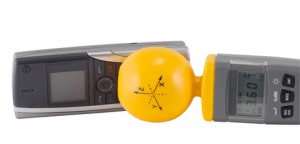
Last week I posted about cell phone radiation, and one of you asked – “should I be worried about electromagnetic fields in general?” In short, yes. But this, my friends, falls into the category of things I think we might need to live with and watch, because short of moving to the boonies and disconnecting ourselves from much of the technology on which we’ve come to rely, there isn’t any great way of completely avoiding EMFs. Read on and decide how hypochondriacal and OCD you’re willing to get over this one . . . . [Read more →]
September 25, 2009 6 Comments
The Hammer’s Coming Down
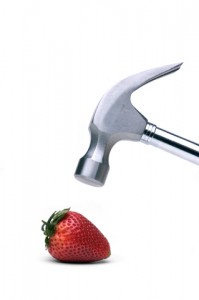
Remember how I mentioned “the boot” on Monday? And how I haven’t been exercising much? Well, I’ve got a confession to make – I got on the scale yesterday and the picture’s not pretty. All this not moving has caused weight gain I’m not comfortable with. Sure, I expect that I’ll spread out at a time like this – I can’t do the gagillion squats and lunges I depend on to keep things in check – but now I know I’ve also been too lax in the eating department.
So, the hammer’s coming down. Back to 1,200 calories. Back to logging everything that goes in my mouth. Back to rules and goals – if I can’t log it, I can’t eat it, and if I make my first goal, I’m treating myself to a massage. Those who know me know I treat myself pretty well – but a massage is a true indulgence for me. It’s definitely something to look forward to if I can reign it in a little bit here for the next month. And that’s how I go about this, and you might want to, too. Small, intermediate goals help you feel the sense of achievement you need to stay on track. Sure, you might want to change your life radically in some way, maybe it’s weight-loss, but if you set a huge goal for yourself it just might be too overwhelming to deal with after a week. I’m all about baby steps – now literally and figuratively (groan).
But another confession, I’ve been enjoying eating anything I want. I’ve been conscious of moderation, but I’ve definitely been eating more calorie-dense foods. I like the variety of foods that being more relaxed has allowed me to eat. So my other goal for this time is to come up with some yummy new ideas for snacks and meals that will still fit into my calorie budget. Add to that the easy-prep angle, and I’ve got a challenge. But lucky for all of us, I love a challenge! [Read more →]
September 17, 2009 1 Comment
Mobile Mania
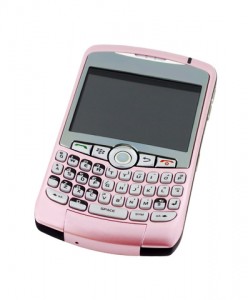
Cell phone safety is all over the news in the last few weeks. It began after a group called the International EMF Collaborative issued a report warning that cell phones may be more dangerous than users have been led to believe by health authorities. Last week, the Environmental Working Group released their online guide to cellphone radiation. And yesterday, Pennsylvania senator and brain cancer survivor Arlen Specter held a U.S. Senate subcommittee hearing to focus on whether cellular phone use causes health problems. At the same time and also in the nation’s capital, attendees at an international conference examined the potential cancer risks of radiation generated by cell phones.
What is going on? The EMF Collaborative report, titled “Cellphones and Brain Tumors: 15 Reasons for Concern,” says the latest research indicates that regular use of cell phones can result in a “significant” risk of brain tumors. It also says kids are at greater risk than adults because their still-developing brain cells are more vulnerable to electromagnetic radiation. This study adds to the mounting evidence which indicates we should reduce our exposures while research continues on this question. Consider this: Americans’ use of cell phones increased 50% last year – fueled in large part by the “smartphone” craze. If cell phone radiation is indeed a problem, it’s going to be a really huge problem in the coming years.
Last week the Environmental Working Group received a lot of attention when it released its comprehensive online consumer guide to cell phone radiation, which rates more than 1,000 cell phones marketed in the U.S. The guide is the culmination of a 10-month research review to understand the risks of cell phone usage. The EWG also found that cell phones emit radiation – enough so that scientists are concerned about potential cancer risks. Using their guide, you can:
- Look up your phone;
- Read and download tips to reduce your exposure;
- See the top 10 best phones;
- Read the full Cell Phone Radiation Science Review;
- Take action and tell the government that it’s time to modernize their radiation standards.
What else can you do now to limit your exposure? If you need a new mobile phone, it’s smart to buy phones with lower radiation emissions – use the EWG guide to figure out which is best for you. Whichever phone you have, it’s a good idea to keep it as far away from your body as possible. Researchers say using the speaker, sending text messages or talking on a headset all cut down on radiation exposure. Opinions differ on whether a wireless Bluetooth headset poses a risk – some scientists at Monday’s hearing said it could be a problem, while others did not. But they all agreed a wired headset is best. And using any headset means less radiation than if you’re holding the phone directly to your ear. Also try making calls when the signal is high so that the phone doesn’t have to work as hard.
What about your kids? Talk to them about these findings, and help them to limit their exposure: kids actually can absorb twice as much radiation as an adult from the same cell phone. If your kids give you flak, let them know that advisories to limit cell phone use have already been issued by numerous countries and advisory boards including: the UK; Germany; France; Russia; India; Israel; Belgium; Japan; the Toronto Board of Health; and the Pittsburgh Cancer Institute. Dr. Devra Davis, Director of the Center for Environmental Oncology at the University of Pittsburgh has said “Children under the age of 12 should not use cell phones unless in an emergency situation. If they must use cell phones, make sure they connect using a headset.”
Read more in the L.A. Times, Wired, Green Living Online, and at CNET.com.
September 15, 2009 4 Comments
Hotlinks

- Michael Pollan on Big Food vs. Big Insurance
- Training apps for your smartphone
- Mark Bittman’s twist on chicken w/40 cloves of garlic
- Are you a “foodie,” “cook,” or “home-cook?”
- Learn to make a Asian fusion dish with Gwyneth (video!)
- What Marion Nestle has to say about BPA
September 10, 2009 No Comments
U Wanna Pick Apples?
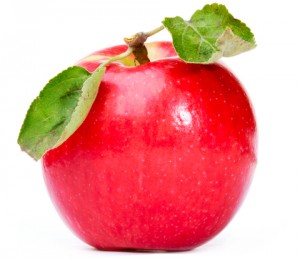
Like it or not, it’s September, and for me, one of the great joys of fall is apple picking. I love to load up on crisp, sweet-tart apples for snacking and baking. But what’s a pesticide-avoiding mama to do? Apples rank number 2 in the EWG’s Shopper’s Guide to Pecticides, with a 93/100 score for pesticide load. Every year so far, I’ve thrown caution to the wind and gone to an orchard that uses conventional pest management practices (Honey Pot Hill in Stowe is my favorite, but more for the doughnuts than anything!).
I decided that this year, we need to get serious and find a place that uses low-spray or organic practices in its orchards, and let me tell you, they’re tough to find. It’s difficult and expensive to grow organic orchard fruit – apples are beset by many pests and diseases. Your only choice for certified organic, pick-your-own apples around here is the Old Frog Pond Farm in Harvard.
Far more farms in the area use Integrated Pest Management (IPM) systems. What’s IPM? IPM has been used by growers and researchers for over 25 years in New England orchards. It’s a “best practices” approach that primarily relies on cultural practices to maintain tree health, and the action of beneficial organisms to manage pests. IPM growers seek to use the lowest possible dosage of the least disruptive pesticide, only when pest populations exceed economic threshold levels and alternative methods are ineffective. As with organic farming, IPM emphasizes plant health and cultural practices as the first line of defense against pests. But unlike organic farming, which allows only the use of pesticides derived from natural sources, IPM does allow the use of synthetic pesticides.
There are 10 choices for IPM pick-your-own in the Greater Boston area:
- Shelburne Farms in Stowe
- Bolton Spring Farm in Bolton
- Nicewicz Family Farm in Bolton
- Autumn Hills Orchard in Groton
- Clearview Farm in Sterling
- Connor’s Farm in Danvers
- Ashby Apples in Ashby
- Russell’s Orchard in Ipswitch
- Kimball’s Fruit Farm in Pepperell
- Cider Hill Farms in Amesbury
If you know of others, add them in the comments, please! And do yourself a favor and call the orchard before you pack up the car and head out – find out what they’re picking on any particular day so you’re not disappointed.
Enjoy!
September 9, 2009 2 Comments
What Is “Green”? “Natural”? “Organic”?

If you’re at a loss sometimes, you’re not alone. A recent survey by the Shelton Group showed that nearly 2/3 of the 1,006 U.S. consumers polled try to purchase foods produced in an environmentally friendly way. But the consumers rated “100% natural” as the most reliable label claim, far ahead of “100% organic.” It seems that consumers think that the word ‘organic’ is more of an unregulated marketing term, when really, the opposite is true. ‘Natural’ is an unregulated word – organic foods must meet government standards to be certified as such.
Want to know more? Here is a guide to what the organic certification really means. And here is a good article from the Chicago Tribune that talks about the Shelton Group study and goes further into the confusion regarding food labeling. The Tribune also has a handy-dandy guide to the difference between “organic” and “natural” labeling on a variety of products that you can find here.
September 2, 2009 No Comments
Great Guide
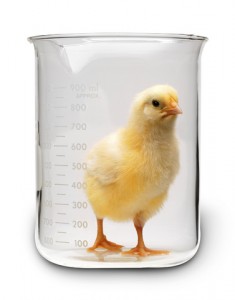
The Institute for Agriculture and Trade Policy/Food and Health Program just released its “Smart Guide” to hormones in the food system. It’s a PDF that you can download, and it has some good history and background information on where different synthetic hormones turn up and why, and also includes some tips on how to reduce your total hormone exposure from food and drink. Check it out for yourself here.
September 1, 2009 No Comments









